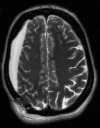Electroconvulsive therapy use for refractory status epilepticus in an implantable vagus nerve stimulation patient: A case report
- PMID: 36816412
- PMCID: PMC9935692
- DOI: 10.3389/fpsyt.2023.1126956
Electroconvulsive therapy use for refractory status epilepticus in an implantable vagus nerve stimulation patient: A case report
Abstract
Introduction: Status epilepticus (SE) has a mortality rate of 20 to 50%, with acute symptomatic SE having a higher risk compared to chronic SE. Electroconvulsive therapy (ECT) has been utilized for the treatment of refractory SE with a success rate estimate of 57.9%. There are no known reported cases of concomitant use of vagus nerve stimulation (VNS) and ECT for the treatment of super refractory SE (SRSE) available in the literature.
Case description: We present a 44-year-old female with a history of developmental delay, epilepsy, an implantable VNS for 6 years, and traumatic brain injury with subsequent hygroma who presented with progressive aphasia, declining mental status, and daily generalized seizures lasting up to 20 min. Seizures had increased from her baseline of one seizure per day controlled with topiramate 200 mg three times daily and lamotrigine 400 mg twice daily. She was diagnosed with SRSE after being intubated and placed on eight anti-epileptic drugs (AEDs) that failed to abort SE. ECT was attempted to terminate SE. Due to a prior right craniotomy with subsequent right hygroma, eight treatments of ECT were performed over three sessions using a right anterior, left temporal (RALT) and subsequently a bitemporal electrode placement. The VNS remained active throughout treatment. Various ECT dosing parameters were attempted, varying pulse width and frequency. Although ECT induced mild transient encephalographic (EEG) changes following ECT stimulations, it was unable to terminate SE.
Discussion: This case describes various treatment strategies, constraints, and device limitations when using ECT for the treatment of SE. With wide variability in efficacy rates of ECT in the treatment of SE in the literature, successful and unsuccessful cases offer information on optimizing ECT total charge dose and parameters that yielded success. This case demonstrates an instance of ECT inefficacy in the treatment of SRSE. Here, we discuss the rationale behind the various ECT settings that were selected, and constraints arising from the antiepileptic burden, VNS, and intrinsic limitations of the ECT device itself.
Keywords: case reports; electroconvulsive therapy; refractory epilepsy; status epilepticus; vagus nerve stimulation.
Copyright © 2023 Katzell, Beydler, Holbert, Rodriguez-Roman and Carr.
Conflict of interest statement
The authors declare that the research was conducted in the absence of any commercial or financial relationships that could be construed as a potential conflict of interest.
Figures
Similar articles
-
Electroconvulsive therapy for super refractory status epilepticus in pregnancy: case report and review of literature.Int J Neurosci. 2023 Dec;133(10):1109-1119. doi: 10.1080/00207454.2022.2050371. Epub 2022 Mar 14. Int J Neurosci. 2023. PMID: 35287528 Review.
-
Successful Treatment of Super-Refractory Status Epilepticus with High-Intensity Electroconvulsive Therapy - A Case Report and Review of the Current Literature.J Epilepsy Res. 2019 Jun 30;9(1):76-82. doi: 10.14581/jer.19008. eCollection 2019 Jun. J Epilepsy Res. 2019. PMID: 31482059 Free PMC article.
-
Vagus Nerve Stimulation (VNS) in Super Refractory New Onset Refractory Status Epilepticus (NORSE).Case Rep Neurol Med. 2019 Jan 21;2019:7852017. doi: 10.1155/2019/7852017. eCollection 2019. Case Rep Neurol Med. 2019. PMID: 30805233 Free PMC article.
-
Vagus nerve stimulation in refractory and super-refractory status epilepticus - A systematic review.Brain Stimul. 2019 Sep-Oct;12(5):1101-1110. doi: 10.1016/j.brs.2019.05.011. Epub 2019 May 14. Brain Stimul. 2019. PMID: 31126871
-
Successful treatment of super-refractory focal status epilepticus: Surgery, vagus nerve stimulation, and botox for epilepsia partialis continua.Epilepsy Behav Rep. 2025 May 2;31:100775. doi: 10.1016/j.ebr.2025.100775. eCollection 2025 Sep. Epilepsy Behav Rep. 2025. PMID: 40895178 Free PMC article.
References
-
- Zeiler FA, Matuszczak M, Teitelbaum J, Gillman LM, Kazina CJ. Electroconvulsive therapy for refractory status epilepticus: a systematic review. Seizure. (2016) 35:23–32. - PubMed
Publication types
LinkOut - more resources
Full Text Sources
Research Materials



